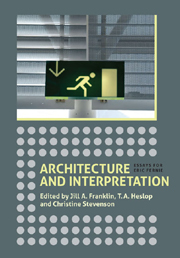Book contents
- Frontmatter
- Contents
- List of Illustrations
- Preface: In Appreciation
- List of contributors
- 1 Introduction
- Incitements to Interpret in Late Antique and Medieval Architecture
- 16 Believing is Seeing: The Natural Image in Late Antiquity
- 42 Articulation as an Expression of Function in Romanesque Architecture
- 60 Barrel-Vaulted Churches in Late Medieval Scotland
- 78 Augustinian and Other Canons' Churches in Romanesque Europe: The Significance of the Aisleless Cruciform Plan
- 99 Towers and Radiating Chapels in Romanesque Architectural Iconography
- 111 Diffusion, Imitation and Evolution: The Uncertain Origins of ‘Beakhead’ Ornament
- 128 Architecture and Pattern: The Western Façade of Lincoln Cathedral and Modernist Reference Points for its Interpretation
- Authors and Intentions
- Architecture beyond Building
- Index
111 - Diffusion, Imitation and Evolution: The Uncertain Origins of ‘Beakhead’ Ornament
from Incitements to Interpret in Late Antique and Medieval Architecture
Published online by Cambridge University Press: 05 April 2013
- Frontmatter
- Contents
- List of Illustrations
- Preface: In Appreciation
- List of contributors
- 1 Introduction
- Incitements to Interpret in Late Antique and Medieval Architecture
- 16 Believing is Seeing: The Natural Image in Late Antiquity
- 42 Articulation as an Expression of Function in Romanesque Architecture
- 60 Barrel-Vaulted Churches in Late Medieval Scotland
- 78 Augustinian and Other Canons' Churches in Romanesque Europe: The Significance of the Aisleless Cruciform Plan
- 99 Towers and Radiating Chapels in Romanesque Architectural Iconography
- 111 Diffusion, Imitation and Evolution: The Uncertain Origins of ‘Beakhead’ Ornament
- 128 Architecture and Pattern: The Western Façade of Lincoln Cathedral and Modernist Reference Points for its Interpretation
- Authors and Intentions
- Architecture beyond Building
- Index
Summary
OVERLOOKING the broad reaches of the river Shannon, about half a mile from the ancient monastery of Clonmacnoise, lie the isolated ruins of the so-called ‘Nuns’ Church’, one of the more lavishly adorned Romanesque buildings in Ireland. Completed in 1167 with the assistance of Devorgilla (Dearbhforgaill), daughter of the king of Meath, this small church was designed to serve a community of Augustinian nuns. The only entrance to the building was through a narrow doorway in the west façade, where the nuns were greeted by a series of monstrous animals, chewing the moulding of the arch (fig. 1). These exotic and once, no doubt, colourful beasts seem at odds with the ideals of a female community where the nuns came to worship, dressed, one assumes, in relatively modest attire. Inside the building, the sculpture was more restrained and, given the dim lighting conditions, must have been difficult to discern. Nonetheless, intriguing details would have been visible amidst the chevron of the chancel arch, not least a cheerful lady exposing herself in front of her female audience. Such confrontations are, of course, ubiquitous in the Romanesque world, an arrangement perplexing for the modern spectator, though not apparently for the medieval clients who paid for the carving.
- Type
- Chapter
- Information
- Architecture and InterpretationEssays for Eric Fernie, pp. 111 - 127Publisher: Boydell & BrewerPrint publication year: 2012

